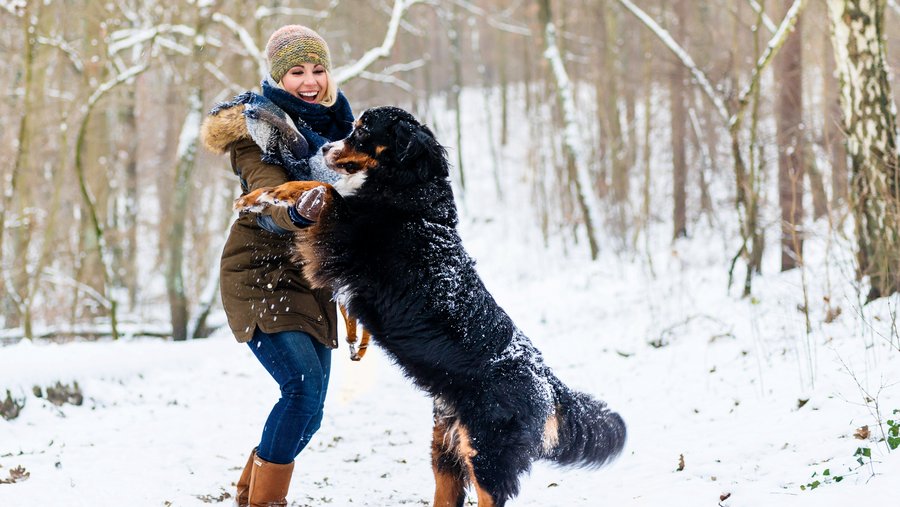The big question first: Do dogs freeze?
Time and again, you see people wrapping their dogs up thickly in winter to protect them from the cold. Others, on the other hand, are completely pain-free and walk their dogs for hours on ice and snow. Why do dogs react so differently to cold temperatures? Mainly because of the breed. As different as dogs are, so is their sensitivity to cold. Dobermans, greyhounds, naked dogs, ridgebacks and so-called "toy dogs", for example, are particularly sensitive to the cold. Short-haired dogs also tend to freeze faster than their long-haired counterparts. This is also due to the nature of their coat. Many long-haired dogs also have an undercoat (undercoat) that protects them from ice and cold. Dog breeds such as the St. Bernard, Akita, Husky, Newfoundland, Wolfspitz and, of course, many guard dogs and herding dogs that are used to living outside are therefore able to withstand the cold. Small dogs are also more sensitive to the cold than large dogs. Weight therefore also plays a role. Health and age also play a role. Over the years, many dog owners will notice that older dogs no longer like to go outside when the weather is at its worst.
How can I tell if my dog is cold?
On the one hand, he doesn't want to go outside. On the other hand, he will look to get close to you when you walk him in order to take advantage of your body heat. A tense posture or a tucked tail also indicate discomfort. If your dog's fur is bristling or he is even trembling, you should take this seriously. Many dogs also seem listless, walk along bored and head back home.
The right dog clothing and equipment in winter.
Even if your four-legged friend normally likes to sleep on the cold tiled floor, you should definitely offer him a blanket or basket now. Rub him down vigorously with a towel when you come home from a walk or romp, as his coat is often still wet. So-called dog bathrobes, which absorb moisture well, can help here. And outside? Is dog clothing useful there? Dogs are often sensitive to the cold on their bellies. For short-legged or small dogs, the belly can therefore be protected with a waterproof dog coat. But there is also a wide range of functional clothing for large, short-haired dogs. The basic rule when choosing is: The dog must be able to move easily despite the clothing so that it can continue to have fun. Fads such as knitted sweaters for dogs are not very practical as they get wet quickly and your dog will usually be even colder than without them.
Now is the right time: extensive paw care.
In the city, you often see dogs wearing dog shoes (booties). In addition to the cold, road salt and grit also damage dogs' paws. Dog booties can protect against injuries here. On the other hand, dogs have a sense of touch in their paws, which is lost. So if you are only out and about with your four-legged friend for a short time on asphalt, you should refrain from wearing booties. Good paw protection and additional paw care in winter are much more important. You should rinse the paws with warm water after every walk. Ideally in a small foot tub so that he doesn't always have to go into the shower. It is also an advantage to keep the fur between the toes short, especially on long-haired dogs. This also prevents annoying lumps of ice from forming on the paws. You can take precautions before the walk and apply special protection. Classic milking grease or Vaseline provide good protection against cracks, drying out, injuries or even frostbite. Of course, you can also buy paw balm especially for dogs. Paw care afterwards can also be done with coconut oil - your dog will love to lick it off. No problem! Coconut oil in particular has a mild antibacterial effect and is well tolerated by your dog's stomach.
Walking in winter - how much is too much?
That depends on your dog's personal preferences. You will know when your dog has had enough of the snow and cold. Just because it's cold doesn't necessarily mean the walks have to be shorter. On the contrary: many dogs love to go for a long walk in the snow with their beloved two-legged friend and romp through the snow. During the walk, you should always make sure that your dog doesn't eat too much snow. So it's best not to play fetch with snowballs, as this can irritate the stomach lining. The previous tip will definitely protect against lumps of snow in paw pads: simply apply a good coat of milking grease or Vaseline to the lower legs and paws.
By the way:
As far as their diet is concerned, you don't have to make any major changes. And you don't have to feed them larger portions either. At most, you will notice that your dog has an enormously higher energy requirement due to the cold. It is therefore advisable to weigh your dog occasionally. This is the best way to see whether he is eating too much or too little.

